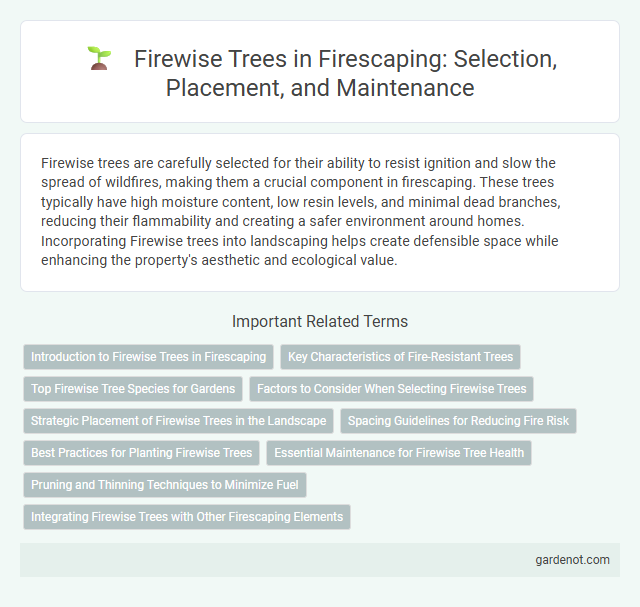Firewise trees are carefully selected for their ability to resist ignition and slow the spread of wildfires, making them a crucial component in firescaping. These trees typically have high moisture content, low resin levels, and minimal dead branches, reducing their flammability and creating a safer environment around homes. Incorporating Firewise trees into landscaping helps create defensible space while enhancing the property's aesthetic and ecological value.
Introduction to Firewise Trees in Firescaping
Firewise trees are specifically selected for their ability to resist ignition and help slow the spread of wildfires in firescaping landscapes. These species typically have low resin content, minimal dead wood accumulation, and maintain high moisture levels in their foliage, reducing flammability. Incorporating Firewise trees like oaks, maples, and certain pines into property design enhances defensible space and supports overall wildfire resilience.
Key Characteristics of Fire-Resistant Trees
Firewise trees typically exhibit thick, moisture-rich leaves, minimal resin or sap content, and open, airy branching structures that reduce fuel density and slow fire spread. Species like oak, maple, and aspen demonstrate these key characteristics, making them highly effective in mitigating wildfire risk. Their ability to retain water in foliage and resist ignition plays a critical role in creating defensible spaces in firescaping efforts.
Top Firewise Tree Species for Gardens
Top Firewise tree species for gardens include Quercus palustris (Pin Oak), Pinus ponderosa (Ponderosa Pine), and Cercis canadensis (Eastern Redbud), known for their low resin content and fire-resistant bark. These species exhibit slower ignition rates and reduce fire intensity due to their moisture-rich foliage. Incorporating Firewise trees into landscapes enhances garden resilience against wildfires and supports safer community defensible spaces.
Factors to Consider When Selecting Firewise Trees
Selecting Firewise trees requires consideration of factors such as high moisture content in leaves and needles, low resin and sap levels, and appropriate spacing to reduce fire spread. Choosing species with thick bark and limited dropping of flammable debris minimizes fuel for wildfires. Incorporating native, drought-tolerant trees adapted to local fire regimes enhances landscape resilience and safety.
Strategic Placement of Firewise Trees in the Landscape
Strategic placement of Firewise trees involves selecting fire-resistant species such as oaks and maples, then positioning them to create defensible space around structures. Maintaining proper spacing between trees, eliminating ladder fuels, and planting Firewise trees away from flammable materials significantly reduces wildfire risk. Integrating these trees with low-flammability ground cover and hardscaping enhances the overall fire-resistant landscape design.
Spacing Guidelines for Reducing Fire Risk
Proper spacing between Firewise trees significantly reduces fire risk by limiting the potential for flame spread and radiant heat transfer. Maintain a minimum of 10 feet between tree canopies and increase spacing based on slope and tree height, with at least 30 feet recommended for trees over 30 feet tall. Regularly prune lower branches to a height of 6 to 10 feet to create vertical clearance that prevents ground fires from climbing into the canopy.
Best Practices for Planting Firewise Trees
Plant Firewise trees with at least 10 feet of space between them and maintain a minimum of 30 feet of clearance from combustible structures to reduce wildfire risk. Choose species with high moisture content, low resin, and minimal leaf litter to enhance fire resistance. Regularly prune dead branches and remove fallen debris to prevent fuel buildup around Firewise trees.
Essential Maintenance for Firewise Tree Health
Essential maintenance for Firewise tree health includes regular pruning of dead or overhanging branches to reduce fuel buildup and enhance fire resistance. Trees should be spaced adequately, at least 10 feet apart, to prevent fire spread and ensure proper airflow, while removing lower branches up to 6-10 feet from the ground creates a defensible space. Consistent watering and mulching around the base maintain tree vigor, minimizing stress and susceptibility to fire damage.
Pruning and Thinning Techniques to Minimize Fuel
Effective pruning and thinning techniques significantly reduce fire risk by minimizing the available fuel in Firewise tree landscapes. Removing lower branches up to 6 to 10 feet from the ground prevents fire from climbing into the canopy, while thinning out dense clusters of branches improves air circulation and reduces heat buildup. Maintaining a clear space between trees, with a minimum of 10 feet apart, further limits the potential for fire spread by reducing continuous fuel sources.
Integrating Firewise Trees with Other Firescaping Elements
Firewise trees, such as native oaks and pines, play a crucial role in creating defensible space by reducing fuel loads and promoting fire-resistant landscapes. Integrating these trees with other firescaping elements like gravel mulch, fire-resistant shrubs, and strategically placed hardscapes enhances overall wildfire mitigation. Proper spacing and maintenance of Firewise trees alongside low-flammability ground covers improve ignition resistance and support landscape resilience during wildfires.
Firewise tree Infographic

 gardenot.com
gardenot.com